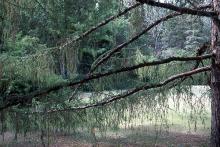Larix gmelinii
Common name:
Dahurian Larch
Pronunciation:
LAR-iks g-mel-IN-ee-eye
Family:
Pinaceae
Genus:
Synonyms:
L. gmelinii var. gmelinii
Type:
Conifer
Native to (or naturalized in) Oregon:
No
- Deciduous conifer, to 35 ft (to 11 m) tall or shrubby, conical, slender crown, branches long, horizontal, sweeping upwards at the tips, branchlets drooping to pendulous. Bark rust-brown. Leaves (needles) in clusters, to 3 cm long, light green, 2 stomatal bands below and a diffuse band above, yellowish in fall. Mature cones about 1.5-3 cm long, ovoid, glossy pale brown, 20-40 scales; bracts to 5 mm, often slightly exerted (projecting beyond the scale).
- Sun, moist, light soil
- Hardy to USDA Zone 1 Native range from eastern Siberia, northeastern Mongolia, northeastern China and Korea. Reportedly along its western margin, the range of L. gmelinii is contiguous with that of L. russica, with which it readily hybridizes to form L. × czekanowski (U.S.D.A. Forest Service General Technical Report GTR-INT-319).
- Several subspecies are distinguished, and the Dahurian Larch is sometimes designated as L. gmelinii var. gmelinii (Krüssmann, 1985). There are only a few selections of this species used in landscapes, one is the very dwarf form, 'Rombeg Park'.




